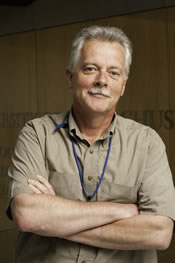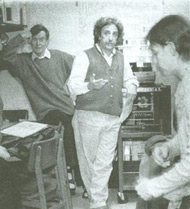Prologue
On April 10, 1978, Chancellor Roger J. Bulger, M.D. wrote an emphatic letter to UMass (interim) President Franklin Patterson, urging him to support a proposal for a "Ph.D. program in Medical Sciences" at the Medical Center in Worcester. As he noted, "This proposal has received the unanimous approval of the Faculty Council and Executive Council of the Medical School."

Dr. Bulger made sure to emphasize that the faculty came here, "expecting to be able to teach in a graduate program and eagerly await its arrival. It will not only contribute further to the intellectual enrichment of the campus, but this enrichment itself becomes an invaluable attraction in our efforts to recruit first-rate clinical faculty ... To put it another way, it is doubtful that high quality faculty would be attracted to an institution which does not have the intellectual ferment and excitement generated by the kinds of scholarly activities which characterize graduate education." On June 7, 1978 the President and the Board of Trustees, gave the new Program their full support.
Background
Just as the Medical School began to plan a graduate program in the biomedical sciences, doctoral education in Massachusetts, and in the U.S. generally, suffered a major demographic setback. By the mid-1970s, the UMass system had begun to cut back many of its doctoral programs in the face of population shifts and waning demand for new PhDs in academia. As a result, the University administration and Board of Trustees emphasized consolidation, streamlining, and avoidance of duplication of graduate programs during most of the 1970s.

An independent program based at the medical campus, however, had been envisioned since 1972. Dean Soutter appointed a formal planning committee of faculty from both the basic and clinical sciences in 1975, chaired by George Wright, Associate Professor of Pharmacology and eventually Director of the Graduate Program.
From early on, its members understood the political facts of life: to win approval for a freestanding degree program, such a program must not cost much (costing nothing was preferred); it must offer a course of study unique to the Worcester campus; it must, if possible, incorporate collaboration with UMass-Amherst and local higher education entities; and finally, it must fill a niche in the potential job market for Ph.D.s. The committee worked for two years to devise an acceptable proposal.
From a Program to a School: Graduate School of Biomedical Sciences, 1986-
On April 2, 1986, nine years after the founding of a Program in Medical Sciences, the University Board of Trustees approved a significant change of status for UMass-Worcester, granting it the right to form a Graduate School of Biomedical Sciences (GSBS).

The force behind this transformation, in similar fashion to George Wright a decade earlier, was Tom Miller, now Emeritus Professor of Biochemistry, Molecular Biology, and Pharmacology. Miller became Wright's successor as Acting Dean of the Program in 1984 and founding Dean of the GSBS. Miller believes that, "It was becoming a trend for Ph.D. programs that were attached to medical schools to seek out their own identity by becoming a school ... So I started a crusade [with] the Graduate Council to change the Graduate Program into the Graduate School of Biomedical Sciences ..."
The draft proposal for the GSBS explained that, "Another compelling reason for this change in status is to give the Ph.D. students themselves an independent identity ... Without this [new] organizational structure, Ph.D. candidates tend to view themselves as second-class citizens vis-à-vis medical or other health science students on campus. In the words of our Dean for Graduate Studies [Tom Miller], the 'identity problem for graduate students in a Medical School, although anecdotal, is real ...'"
The GSBS was highly successful. By 1986 over 130 faculty participated in the Program; an M.D./Ph.D. program had been initiated in 1983, a signal of its growing importance and the wide involvement of faculty across the basic/clinical research borders.
The GSBS Today
Today, hundreds of faculty members participate in the GSBS curriculum, while nearly 450 students are currently enrolled in its programs and have gone on to stellar careers in academia, pharmaceutical companies, and industry, from tiny start-up companies to giants in their fields.

When in 2002 Tom Miller decided to take early retirement, he was succeeded by Dr. Anthony Carruthers, the GSBS's current Dean. Dr. Carruthers first came to the Medical School in 1982-as a Research Associate. He has participated in the Graduate School's development at each phase. He believes that one of its greatest strengths is the School's interdisciplinary curriculum. As he told an interviewer in 2004, "Our faculty determined it's not enough for our students just to do neuroscience or biochemistry or cell biology. They must have a core understanding of the principles involved in all these areas."
Thus the core curriculum—originally the product of political expediency imposed by the need not to be duplicative—has become a signature feature of the GSBS. Indeed it is likely that most graduate schools on medical campuses now introduce students to basic science research in just this way.
Newer initiatives are reflected in the two divisions that currently structure the GSBS coursework. They include Basic and Integrative Biology and Clinical and Translational Sciences. Such expansion and differentiation have allowed for the incorporation of new specialty tracks such as the programs in Clinical and Population Health Research or Bioinformatics and Computational biology.
Whether students work in a wet lab, in a computer lab, or design clinical trials, the end goals are the improvement of health and the prevention of disease.

